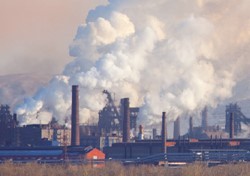
Contact Details:
Freudenberg Filtration Technologies (Pty) Ltd
48 Koornhof St
Meadowdale
Germiston
Gauteng
South Africa
Tel: +27 11 929 4500
Fax: (0)11 392 2116
Send Enquiry | Company Information

Particulate matter: more dangerous than thought
Product News Tuesday, June 13, 2017: Freudenberg Filtration Technologies (Pty) Ltd
Studies show that the smallest particles in the unfiltered air we breathe harm our health. Fine dust with a particle size smaller than 10 micrometers (PM10) reaches the upper part of the respiratory tract. Dust smaller than 2.5 microns (PM2.5) penetrates into the bronchi and below 1 micron it reaches the central region of the lung. Ultra-fine particles (smaller than 0.1 microns) can even penetrate the cell membranes and spread through the body via the bloodstream. The possible consequences include respiratory problems, reinforcement of atherosclerosis, allergy symptoms and asthmatic attacks, heart disease, heart attack and lung cancer.
Particulate matter shortens our lives
Study results show that fine dust shortens life expectancy in the European Union (EU) by around 8.6 months. An estimated 348,000 people in the EU die prematurely each year due to particulate matter, about 47,000 of them in Germany. The smaller the particles are, inhalation of fine and ultra-fine dust particles leads to an increasing risk of cancer, independent of their chemical composition. People who inhale fine dust over a longer period have an increased risk of heart attack. This also applies to dust loads below the currently applicable EU limits.
What is particulate matter?
The definition of particulate matter goes back to the “National Air Quality” standard for particulate matter introduced in 1987 (abbreviated as PM-Standard) of the United States Environmental Protection Agency EPA (Environmental Protection Agency). According to this standard, PM10 is a category of particles whose aerodynamic diameter is less than 10 micrometers (10 microns). The term “particulate matter” represents the totality of tiny particles from different sources, such as erosion, sandstorms, volcanic ash, pollen, fungal spores, bacteria or viruses. Among the anthropogenic sources are power and district heating, transport, diesel exhaust, brake and tire wear and road dust. Not all particles are equally dangerous, but highly toxic soot particles are particularly critical.
Limits are permanently being exceeded
Directive 2008/50/EC of the European Parliament – commonly known as the “air quality guideline” – sets out air quality and cleaner air guidelines for Europe. According to this directive, the daily average of 50 micrograms of PM10 per cubic meter may only be exceeded 35 times a year. However, many German cities reach higher values. Stuttgart exceeded the limit 44 times in 2013 – more than any other German city. If it were up to the World Health Organization (WHO), there should be no instances of exceeding the limit at all. Environmental zones only provide limited help. According to research by Dr. Peter Morfeld in cooperation with the University of Cologne, environmental zones only succeed in reducing PM10 by less than one percent. Looking at ultra-fine particles (less than 0.1 micrometer) provides another perspective. These particles have declined by about a third since the introduction of environmental zones, as Professor Wiedensohler from the Leibniz Institute for Tropospheric Research has been able to prove. Both the EU and the WHO have set limits for outside air, but none yet exists for indoor air. Here’s where it gets interesting.
90 percent of the day is spent indoors
There are many sources of air contaminants to be found indoors. These include dandruff, hair and germs from humans and domestic animals, as well as plasticizers and solvents (gases), which enter the indoor air via building materials or furniture. The surprising fact is that pollution of indoor air from noxious gases and particles is often greater than that of outdoor air. According to the German Federal Environment Agency, the average concentration in rooms with hard floors is typically around 60 micrograms per cubic meter – exceeding the daily EU limit value for PM10 by 10 micrograms.
Freudenberg solutions
Recent developments, such as increasing particulate pollution and the increasing focus on the quality of indoor air, clarify the necessity and demand for the tasks that Freudenberg has set itself as a manufacturer of top-quality filtration solutions. With over 60 years of filtration experience in general industrial air filtration, our experts develop filtration solutions that offer protection against fine dust in a huge variety of areas. From human, environmental and sensitive industrial processes, to dust-removal technology, clean rooms, painting plants and gas turbines, healthcare, shipping, or even in the home. Our solutions help to improve the quality of life in countless settings.
